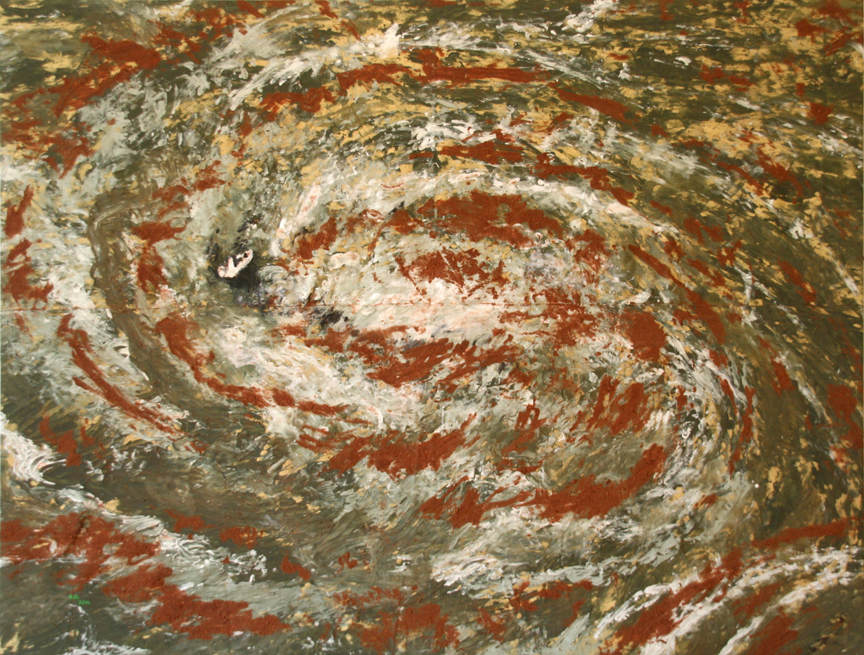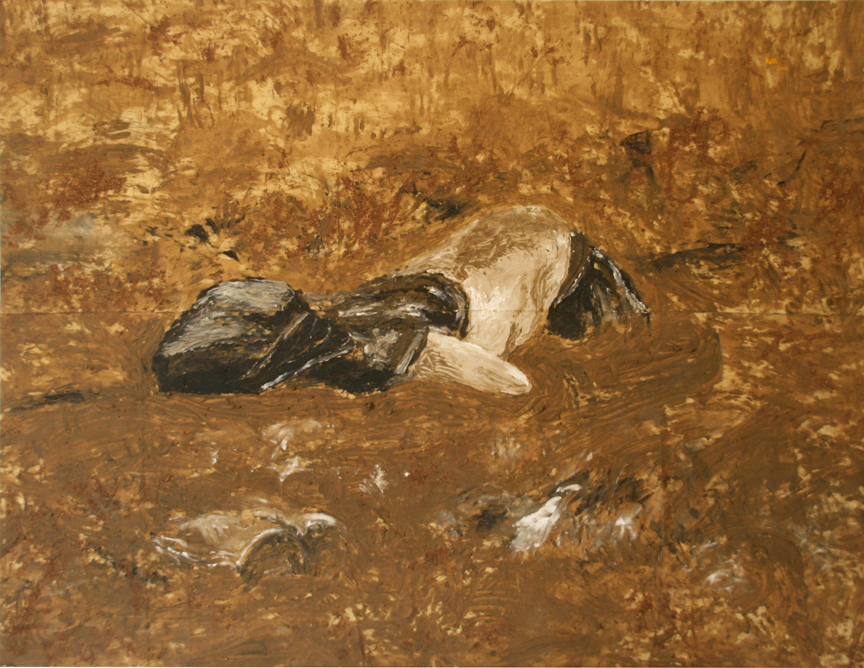Shows
Chea Sereyroth’s “Mohuntakray (Disaster)”


Chea Sereyroth
Mohuntakray (Disaster)
Romeet Contemporary Art Space
Phnom Penh
An anonymous figure lies face down in the mud, apparently dead; a fishing boat is dwarfed by the ominous swirl of a tsunami. “Mohuntakray (Disaster)” (2014) is a series of ten paintings by Chea Sereyroth that depict calamities, both human-made and natural. Revealing at once the fearsome power of nature and the tragic folly of humanity, this exhibition at Romeet Contemporary Art Space in Phnom Penh marks a high point in contemporary figurative paintings in Cambodia, with the artist displaying a surprising unity of concept and materials.
Ranging in various sizes, the canvases in “Mohuntakray (Disaster)” are all coarsely weaved and unprimed, some with visible seams where two pieces of fabric have been sewn together. They are daubed with acrylic paint, sawdust and mud in complementary shades of brown, grey, black and white, all applied directly by hand and without the use of a brush or knife. The muted palette is seemingly drawn from the natural environment around the artist’s home in Battambang, a northwestern province known as the “rice bowl” of Cambodia. The elegant, textural interplay between the rough canvas support surface and heavy impasto is heightened by visible fingerprints, as well as the ghostly presence of loose, gestural pencil sketching in several works. Some paintings, such as Radiation and Tsunami, initially appear almost abstract; these are all works that reward close and careful inspection. The generously spaced installation of the series is, thus, well judged.

In Tornado, a billowing cloud dominates the square canvas. Chea’s use of sawdust and mud here is essentially indexical: the layering of natural fibers very directly evokes the gritty intensity of a violent storm filled with precisely this kind of debris. By contrast, in Tsunami the artist manages to use the very same materials to conjure the surge of an unstoppable ocean swell; here, the sawdust and mud function rather as colors and textures that are interweaved with those of the acrylic paint and raw canvas.
According to Chea, the works are inspired mostly by images he finds online. The specific sources are unimportant; the artist is not interested in depicting actual events, and indeed the ambiguity of Chea’s apparent commingling of natural disasters with scenes of war only heightens their powerfully eerie effect. Whether or not the artist’s practice would benefit from more precise research is an open question. But as they are, the paintings in “Mohuntakray (Disaster)” simultaneously insist on the impressive might of nature and the pitiable plight of its victims; the works harness their visual and referential indistinctness as a strength rather than a shortcoming. The unclear (and undecided by the artist) nature of whether a figure lying face down in the work Deep in the Mud is male or female, or young or old, intensifies the grim sense of horror the picture invokes.

These are works that bravely engage with big issues of ecological devastation, while also displaying a deeply intuitive relationship to their materials. Yet “Mohuntakray (Disaster)” manages to avoid being preachy or overly self-reflexive. Chea Sereyroth navigates the challenges of painting in the 21st century with a rare boldness.
Chea Sereyroth’s “Mohuntakray (Disaster)” was on view at Romeet Contemporary Art Space through June 25, 2014.
Roger Nelson is a curator, critic and PhD candidate based in Cambodia.







